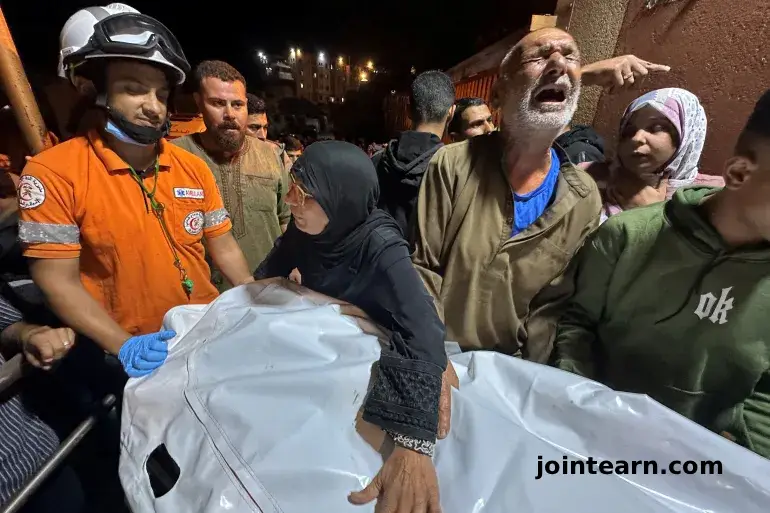
The Palestinian group Hamas has handed over the bodies of two deceased Israeli captives to the Red Cross, a day after renewed Israeli air strikes shattered the fragile ceasefire in the Gaza Strip. The exchange marks another tense chapter in the two-year-long war between Israel and Hamas, as both sides accuse each other of violating the terms of the US-brokered truce.
Israel Confirms Receipt of Bodies via the Red Cross
The office of Israeli Prime Minister Benjamin Netanyahu confirmed on Thursday that Israeli forces received the bodies through International Committee of the Red Cross (ICRC) channels in Gaza.
Israeli authorities identified the deceased as Amiram Cooper (also spelled Kuper) from Kibbutz Nir Oz, and Sahar Baruch from Kibbutz Be’eri — both abducted during the Hamas-led attacks on October 7, 2023.
The Israeli Health Ministry said post-mortem examinations would be conducted at Abu Kabir Forensic Institute in Tel Aviv to determine the causes of death.
Background: Ceasefire Agreement Under Strain
Under the US-mediated ceasefire accord, Hamas agreed to release 20 living captives in exchange for nearly 2,000 Palestinian political prisoners held by Israel. The deal also included Israel’s partial troop withdrawal from several urban centers in Gaza.
However, the truce has been repeatedly tested. Since October 10, Israeli attacks have killed dozens of Palestinians, with the Gaza Health Ministry reporting 104 deaths between Tuesday and Wednesday alone — including 46 children and 20 women.
Israel claims its recent operations are “precise strikes” targeting “terrorist infrastructure,” but residents and aid agencies report that civilian areas have suffered extensive damage.
Hamas: Logistical Challenges Hamper Body Recovery
According to the ceasefire terms, Hamas pledged to return the remains of all 28 Israeli captives who died in Gaza in exchange for the bodies of Palestinians killed in Israeli bombings.
By Thursday, Hamas said it had delivered 15 sets of remains and was continuing efforts to locate others buried beneath the rubble.
Al Jazeera’s correspondent Tareq Abu Azzoum, reporting from az-Zuwayda in central Gaza, said Hamas faces significant “logistical and operational challenges” in retrieving bodies due to ongoing Israeli bombardments.
“Hamas has been requesting the entry of heavy machinery and bulldozers to clear the debris, but Israel continues to accuse the group of deliberately delaying the process,” Abu Azzoum reported.
Trump’s Mediation Efforts Face Obstacles
The dispute over the recovery and transfer of bodies has become a major obstacle to US President Donald Trump’s peace initiative, which aims to bring an end to the prolonged Israel-Gaza conflict.
Key sticking points remain unresolved — including the future governance of Gaza, Israel’s demand that Hamas disarm, and disputes over humanitarian coordination.
Israeli Strikes Resume Across Gaza
Witnesses reported that Israeli aircraft launched at least 10 air strikes early Thursday in Khan Younis and surrounding areas, while tanks shelled eastern Gaza City, particularly near Tuffah and Shujayea neighborhoods.
Local sources told Al Jazeera that entire residential streets were demolished as part of a systematic campaign to clear eastern Gaza City.
Residents described bulldozers flattening homes and infrastructure amid fears that more mass displacement is imminent. Over two million Palestinians — most of Gaza’s population — have been displaced multiple times since the start of the war.
Humanitarian Situation: UN and NGOs Urge Expanded Aid Access
The United Nations reported that more than 24,000 tonnes of humanitarian aid have entered Gaza since the ceasefire began but said that bureaucratic and logistical barriers continue to hinder distribution.
Ramiz Alakbarov, UN Deputy Special Coordinator for the Occupied Palestinian Territory, said:
“The implementation of the 20-point ceasefire plan remains central for delivering aid holistically. NGOs must be allowed to participate freely.”
The World Food Programme’s regional director, Samer Abdel Jaber, confirmed that in just 20 days, humanitarian teams managed to collect 20,000 metric tonnes of food inside Gaza, but warned that without expanded NGO access, relief efforts will stall.
Israel has restricted NGO registrations, which Alakbarov called a “bottleneck issue,” emphasizing the “essential role of local and national NGOs” in maintaining aid flows.
Widespread Destruction and Civilian Displacement
Satellite images and on-the-ground footage show mass destruction across Gaza’s northern and central districts. Many displaced families remain in makeshift shelters without access to clean water, electricity, or medical care.
Humanitarian groups warn that unless aid routes are opened and reconstruction efforts are permitted, Gaza could face a worsening humanitarian catastrophe within weeks.


Leave a Reply